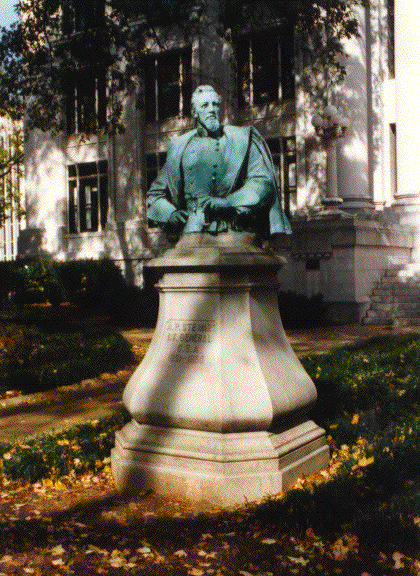William Stewart married Elizabeth Decherd (pronounced Deckard) daughter of wealthy Peter Decherd, and settled in Blountville for two years (1816-1818). They lived in Rogersville 1819-1830 and it was here that their seven children were born, with the exception of one who was born in Abington, Virginia. In his early boyhood his parents moved from Rogersville to Winchester, Tennessee. After their move to Winchester, Tennessee in 1831, they had seven more children.
Records show that the William Stewart house was situated on a lot bordering what is now North Church Street, extending to the north side of where Lyons Hospital was built. It was in that home that Alexander was born. The house and lot William Stewart had bought in Rogersville for $350, he sold for $600.
From Winchester, he was sent in 1838 to be educated in the United States Military Academy at West Point. From this school he graduated in 1842, in the same class with General W. S. Rosecrans, General John Pope, and General John Newton of the Federal Army, and General Gustavus W. Smith and General James Longstreet of the Confederate Army. After graduating he served one year in the artillery, and was then sent to West Point as a teacher of mathematics. After teaching two years in the Military Academy he resigned from the army and accepted a professorship in Cumberland University. Later he became a member of the faculty of the University of Nashville, and occupied this position until the beginning of the Civil War. He entered the Confederate Army as Major of Artillery and rose steadily to the rank of Lieutenant General, the highest except one in the service.
From the battle of Belmont, Missouri, in November, 1861, to the battle at Coe’s Farm, North Carolina, April 1865, General Stewart took part in all the campaigns of the Army of Tennessee.
He was put in command of the heavy artillery and water batteries and was under this command when the battle of Belmont was fought (November 7). A shot from the big gun, the “Lady Polk,” which burst a few days afterward killing eleven men and injuring others, was fired by Maj. Stewart’s orders at Grant’s line of troops, then in plain view fromt the bluff where it was mounted, followed by other shots, causing Grant’s forces to face to the left and move off soon at a double quick. Soon after this, Maj. Stewart was appointed a brigadier General on the recommendation of Albert Sidney Johnston.
He won his last promotion at New Hope Church. Stewart’s Division in one line of battle all the evening mowed down fighting Joe Hooker’s Corps. It was a desperate fight, and Gen. Johnston was so gratified that he said to Gen. Stewart, “If I can make you a Lieutenant-General for you management, you shall have it.” In a few weeks, Old Joe came out to where General Stewart was superintending a redoubt, bringing his commission.
At the close of the war General Stewart returned to Lebanon and again became a professor in Cumberland University. In 1874 he was elected President of the University of Mississippi at Oxford, where he remained for twelve years. In 1890 the United States Congress passed and act to make a National Military Park of the battle fields around Chattanooga and at Chickamauga. General Stewart, who lived in Chattanooga for a time, was appointed one of the commissioners to take charge of this work and held that position until his death in 1908.
In the years before his death, he was considered a modest and gentlemanly scholar who enjoyed pursuing literary interests. He died in Biloxi, Mississippi, August 30, 1908 and is buried in St. Louis.
When he died, only one other former Confederate lieutenant general, Gen. Simon Bolivar Buckner, was still living.
The General A. P. Stewart Chapter of the Daughters of the Confederacy in Chattanooga had been named in his honor a few years before his death. On April 22, 1919, the chapter dedicated the bust of him on the courthouse lawn. It was designed by the noted Tennessee artist Belle Kinney and cast at the famous Tiffany Studios in New York.

Sources:
HISTORY OF TENNESSEE, American Book Company, Copyright 1927, by Ora McGee Brandau
CONFEDERATE VETERAN - B. L. Ridley’s Journal.
CHATTANOOGA FREE PRESS, October 1995, A-2
ROGERSVILLE REVIEW, Article by Tom Bowen
Historical Marker, Tennessee Historical Commission, Rogersville, Tennessee
Photo of Stewart bust at Chattanooga by Ralph Williams

Copyright © 1999-2001 by Sheila Weems Johnston, Rogersville, TN
Page created 9/1/99